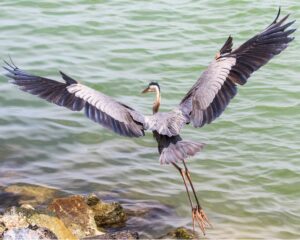by Davin Dahl, summer intern
While on an early morning run, I looked to my left toward the West Twin River. Gliding over the surface of the river was a pair of Great Blue Herons. The smoothness of their movements caught my eye, and I could not keep myself from watching them as they landed on the river’s edge.
 These giant birds often reach a height of over four feet, with a wingspan of nearly seven feet, though they are still extremely light for their size. They usually weigh about 5 pounds, getting up to 8 pounds at most. This is due to its hollow bones. Their blue-gray color and size distinguish them from other birds. They can be found along the water, often in marshy areas. Their nests can be seen high up in trees near or above water.
These giant birds often reach a height of over four feet, with a wingspan of nearly seven feet, though they are still extremely light for their size. They usually weigh about 5 pounds, getting up to 8 pounds at most. This is due to its hollow bones. Their blue-gray color and size distinguish them from other birds. They can be found along the water, often in marshy areas. Their nests can be seen high up in trees near or above water.
Great Blue Herons can be seen year-round at Woodland Dunes. They can be seen along the water’s edge stalking for their food. They enjoy eating almost anything that they can get their feet or beak on, including fish, amphibians, insects, small mammals, reptiles, and birds.
They are often seen alone, stalking the water’s edge, or gliding over the water’s surface in search of food. When they breed, they nest in colonies of several hundred pairs. They mate with one partner each season, but the partner changes from year to year. They lay 2-6 light blue eggs, with two hatchlings often surviving.
I now find myself looking for running routes that take me near water, so that I have a better chance of seeing a Great Blue Heron silently stalking the water’s edge or gliding overhead.
Photo: National Audubon Society
